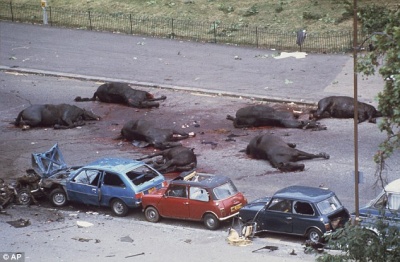Hyde Park bombing
 Aftermath of the Hyde Park bombing, 20 July 1982 | |
| Date | 20 July 1982 |
|---|---|
| Location | London, England |
| Blamed on | Provisional Irish Republican Army |
| Type | Bombings |
| Deaths | 11 |
| Injured (non-fatal) | 50 |
The Hyde Park bombing occurred on 20 July 1982 when the Provisional IRA detonated a nail bomb in the boot of a car parked on South Carriage Drive in London's Hyde Park.[1]
The explosion killed four soldiers of the Blues and Royals regiment and seven Household Cavalry horses. The other soldiers in the procession were badly wounded, and a number of civilians were injured.[2][3]
The Hyde Park bombing came just over a year after IRA hunger striker Bobby Sands died in the Maze Prison. The IRA claimed responsibility by deliberately mirroring Prime Minister Margaret Thatcher's words a few months before when Britain entered the Falklands War:
- "The Irish people have sovereign and national rights which no task or occupational force can put down".
Reacting to the bombings in Hyde Park and Regent's Park, Thatcher said:
- "These callous and cowardly crimes have been committed by evil, brutal men who know nothing of democracy. We shall not rest until they are brought to justice."
The bombings had a negative impact on public support in the United States for the Irish republican cause.[4]
Contents
Remote-control
Explosives experts believed that the Hyde Park bomb was triggered by remote-control by an IRA member inside the park. It exploded at 10.40am just as members of the Royal Household Cavalry, Blues and Royals, were passing. A huge nail bomb, containing up to 25lbs of high explosive, was hidden in a blue Morris Marina car that had been parked on South Carriage Drive and was detonated by remote-control as the soldiers rode past. They were taking part in their daily Changing of the Guard procession from their barracks in Knightsbridge to Horse Guards Parade.[5]
Fatalities
Lieutenant Anthony Daly, 23, Trooper Simon Tipper, 19, and Lance Corporal Jeffrey Young, 19, were killed outright and Squadron Quartermaster Corporal Roy Bright, 36, the standard bearer, died from his injuries four days later. Lt Daly and Tpr Tipper had each been married for less than a month when they died.
Seven horses were killed but another, Sefton, became a national icon and symbol of hope after recovering from 34 injuries and an eight-hour operation. The black gelding was given a 50/50 chance of survival, but recovered sufficiently to return to military service for a further two years, was featured on television programmes, awarded "Horse of the Year" and lived until 1993.[6]
Sefton's rider, Michael Pedersen, who was injured in the Hyde Park bombing, also became a national hero but tragically in 2012 he took his own life and those of his two young children.[7]
Criminal proceedings
Danny McNamee
In October 1987, 27-year-old Gilbert "Danny" McNamee, from County Armagh, was sentenced at the Old Bailey to 25 years in prison for his role in the Hyde Park bombing and others, despite his plea that he was not guilty. In December 1998, shortly after his release from the Maze prison under the Good Friday Agreement, three Court of Appeal judges quashed his conviction, deeming it "unsafe" because of withheld fingerprint evidence that implicated other bomb-makers. They stated that though the conviction was unsafe it did not mean Danny McNamee was necessarily innocent of the charge.[8]
John Downey
On 19 May 2013, 61-year-old John Anthony Downey, from County Donegal, was charged with murder and intending to cause an explosion likely to endanger life in relation to the Hyde Park bombing. He appeared by videolink from Belmarsh prison for a bail hearing at the Old Bailey on 24 May 2013 and did not apply for bail so was remanded in custody.[9] At a hearing on 1 August 2013, Downey was granted conditional bail and a trial was scheduled for January 2014.[10]
On 24 January 2014, John Downey appeared at the Old Bailey for the beginning of his trial; he entered a not guilty plea on the four murder charges and the charge of intending to cause an explosion.[11] On 25 February 2014, it was revealed that Downey's trial had collapsed after the presiding judge had ruled, on 21 February, upon a letter sent by the Police Service of Northern Ireland to Downey in 2007, assuring him that he would not face criminal charges over the attack. Although the assurance was made in error and the police realised the mistake, it was never withdrawn, and the judge ruled that therefore the defendant had been misled and prosecuting him would be an abuse of executive power.[12] Downey is one of 187 IRA suspects who received secret on-the-run letters guaranteeing them unofficial immunity from prosecution.[13]
The Official Culprit
| Name |
|---|
| Provisional Irish Republican Army |
References
- ↑ David McKittrick Lost Lives: The stories of the men, women and children who died as a result of the Northern Ireland Troubles. Random House, 2001. pp.908–909
- ↑ "IRA bombs cause carnage in London"
- ↑ "Hyde Park IRA bombing: 1982 bombing was one of the worst mainland atrocities"
- ↑ Chalk, Peter. Encyclopedia of Terrorism. ABC-CLIO, 2012. pp.614–615. ISBN 0313308950
- ↑ "Horse Guards"
- ↑ "Sefton, Battle of a War Horse"
- ↑ "Pedersen deaths: Father killed children and himself". BBC News. Retrieved 25 January 2014.Page Module:Citation/CS1/styles.css must have content model "Sanitized CSS" for TemplateStyles (current model is "Scribunto").
- ↑
{{URL|example.com|optional display text}} - ↑
{{URL|example.com|optional display text}} - ↑
{{URL|example.com|optional display text}} - ↑ "IRA Hyde Park bomb: John Downey denies murder". BBC News. 24 January 2014. Retrieved 25 January 2014.Page Module:Citation/CS1/styles.css must have content model "Sanitized CSS" for TemplateStyles (current model is "Scribunto").
- ↑
{{URL|example.com|optional display text}} - ↑
{{URL|example.com|optional display text}}
Wikipedia is not affiliated with Wikispooks. Original page source here